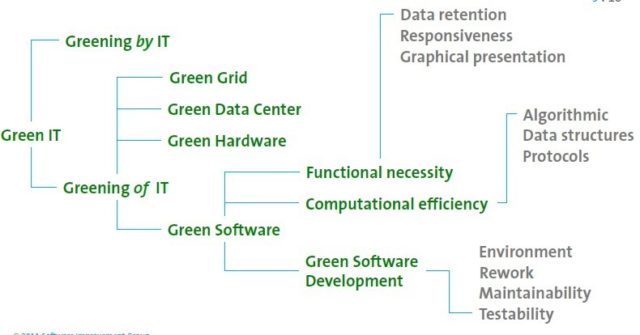Green ICT and Green Hardware
Green ICT (Information and Communication Technology) is more than just reduce carbon emissions or reducing the energy consumption of ICT companies. Green ICT is a technology center sustainability (Philipson, 2011). Green IT provides:
- measurement tools,
- data storage,
- reporting mechanisms, and
- mitigationtechniquesthatenablesustainability.
According Stollenmaye (2011) in an article entitled How the Earth can benefit from Green ICT, Green ICT is critically important in terms of sustainable economic development. ICT field is very broad, the reduction of carbon emissions is only one example. This is the Taxonomy of Green ICT :
Fig 1. Show the toxonomy of green IT that clasify and spesify green IT to several part.
According hanle (2009: 6) benefits of green ICT is divided into multiple stakeholders, as follows :
- The benefitstothe environment:
- Reducingcarbon dioxideemissions,
- Reducingthe consumptionof resources,
- Abide bythe rules(in the future).
- The benefitsforcompanies:
- Savethe electricalload.
- Reducing the burden ofdata center operations.
- Requireslesshardware.
- Benefitsforemployees:
- Increaseemployee satisfaction
- Loyaltylarger
- Recruitmenteasier
- The benefitstothe market:
- Assessmentincrease
- The stock pricehigher
- Valueslarger company
- CustomerBenefits:
- Greater customerloyalty
- Interestfornewcustomers
- Greater customersatisfaction
- PublicBenefits:
- Improved itscorporate image
- greaterbrandvalue
Green Hardware
According Murugesan (2012), green hardware can not be built with just having an extra step in the life cycle of the device. There needs to be a concerted effort at every stage of the life cycle of the device conceived, developed to be used and recycled or discarded. Green hardware need to do several steps, so that the company is easier to implement green.Green hardware is energy consumption by making small changes in how we use computers behavior. Most desktop computer is running, even when they do not use it anymore, because users sometimes always leave their desktop turned on, it can increase spending excessive electricity (Murugesan, 2012).
We can reduce PC energy consumption by following a few steps:
- Allows the power management features. Without the need to sacrifice performance, can also program your computer to automatically turn off the power source when not using the energy-efficient computer systems.
- Turn off the system when not in use. This is the most fundamental energy savings, there is a conservation strategy for most systems.
- Using screensaver. A blank screen saver savings rather than displaying a moving power, which constantly interact with the CPU. But this can only reduce energy consumption monitor small part.
References :
Murugesan, S. (2012). Harnessing Green IT: Principle and Practise.
P, S. (2011). How The Earth can Benefit from Green ICT. Green ICT, No. 2.
Philipson, G. (2011). A Framework of Green Computing. International Journal of Green Computing.


